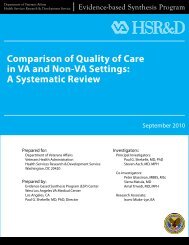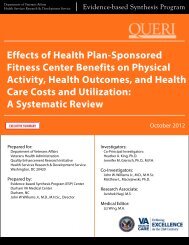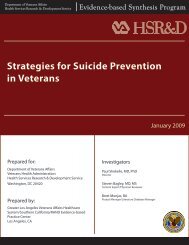VHA Systems Redesign; Transformational change in health care ...
VHA Systems Redesign; Transformational change in health care ...
VHA Systems Redesign; Transformational change in health care ...
Create successful ePaper yourself
Turn your PDF publications into a flip-book with our unique Google optimized e-Paper software.
316 Health Care Management REVIEW<br />
October–December 2007<br />
First, these <strong>in</strong>itiatives, such as cl<strong>in</strong>ical redesign,<br />
improved operations. Those with susta<strong>in</strong>ed impact<br />
progressed beyond short-term improvement to build <strong>in</strong>to<br />
rout<strong>in</strong>e work new practices that were visible, easier to<br />
perform, more reliable, and more efficient than old<br />
practices. Leaders <strong>in</strong> Site F, for example, found that<br />
improvement <strong>change</strong>s did not stick once special project<br />
resources were removed unless the system itself <strong>change</strong>d.<br />
In a surgical <strong>in</strong>fection project, the site <strong>in</strong>itially improved<br />
prophylactic antibiotic use through the use of guidel<strong>in</strong>ebased<br />
rem<strong>in</strong>ders and education but <strong>change</strong>d its approach<br />
after performance plateaued. To reach a zero-defect level,<br />
the site reeng<strong>in</strong>eered its practices to provide patients with<br />
antibiotics at a specific moment <strong>in</strong> the preoperative<br />
process signaled by explicit physical cues. As a result, the<br />
site atta<strong>in</strong>ed consistently high performance without<br />
additional resources.<br />
Second, improvement <strong>in</strong>itiatives actively engaged<br />
staff across discipl<strong>in</strong>es and hierarchical levels <strong>in</strong> problem<br />
solv<strong>in</strong>g around a concrete, mean<strong>in</strong>gful, urgent problem.<br />
In the study systems, such engagement resulted <strong>in</strong> skill<br />
development, a newly honed sense of <strong>in</strong>quiry and problem<br />
solv<strong>in</strong>g, and more rigorous use of data. Equally<br />
important, engagement <strong>in</strong> problem solv<strong>in</strong>g generated<br />
a palpable sense of enthusiasm and accomplishment.<br />
As on person <strong>in</strong> Site F said,<br />
It was very reward<strong>in</strong>g to see how excited staff and<br />
physicians were about mak<strong>in</strong>g these <strong>change</strong>s. It<br />
became a competition; it was fun and we celebrated<br />
successes, <strong>in</strong> part by post<strong>in</strong>g the successes...It is part<br />
of the ‘pull.’ Doctors, respiratory therapists, etc. travel<br />
to all units and communicate ‘what’s do<strong>in</strong>g’ to other<br />
units. If it is good, people say ‘why can’t we have that?’<br />
Third, successful <strong>in</strong>itiatives built momentum for<br />
further <strong>change</strong> and improvement. They contributed to<br />
culture <strong>change</strong> when the cl<strong>in</strong>ical focus for improvement<br />
was aligned with the organizational mission and<br />
strategic direction, was an area need<strong>in</strong>g improved<br />
performance, and had scientifically valid evidence on<br />
which to base redesigned practices. Projects <strong>in</strong>cluded<br />
improv<strong>in</strong>g cl<strong>in</strong>ical <strong>care</strong> for patients with acute conditions,<br />
such as heart attack or stroke, and with chronic<br />
conditions, such as asthma. Such projects engaged cl<strong>in</strong>ical<br />
staff because of their unmistakable cl<strong>in</strong>ical importance<br />
and because of the momentum built by<br />
<strong>in</strong>cremental, short-term ga<strong>in</strong>s.<br />
Alignment<br />
Alignment, as def<strong>in</strong>ed <strong>in</strong> the Baldrige framework<br />
(Baldrige National Quality Program, 2005), refers to<br />
consistency of plans, processes, <strong>in</strong>formation, resource<br />
decisions, actions, results, and analysis to support key<br />
organization-wide goals. An important factor <strong>in</strong><br />
successful organizational <strong>change</strong>, alignment is represented<br />
<strong>in</strong> Figure 1 as a vertical l<strong>in</strong>e to signify its role<br />
<strong>in</strong> mov<strong>in</strong>g work at all levels of the organization <strong>in</strong> a<br />
consistent direction.<br />
The study systems used different methods to convey<br />
their messages to ensure consistent visions and purposes<br />
across the organization. The leadership at Site D, for<br />
example, identified 18 corporate strategies that def<strong>in</strong>ed<br />
the organization’s direction and priorities. Staff members<br />
throughout the organization became familiar with<br />
these strategies and their mean<strong>in</strong>g.<br />
Effective alignment required not only shared understand<strong>in</strong>g<br />
of purposes and goals but also deployment<br />
of resources to re<strong>in</strong>force the behaviors, operations, and<br />
processes that supported organizational goals Study<br />
systems varied <strong>in</strong> how they accomplished this deployment,<br />
with several actively employ<strong>in</strong>g the Baldrige<br />
framework to create highly aligned priorities. In most<br />
systems, though, organizational priorities were translated<br />
<strong>in</strong>to department goals for which managers were held<br />
accountable. Some systems carried alignment down<br />
to the front l<strong>in</strong>e of the organization. Site I, for <strong>in</strong>stance,<br />
cascaded its organizational objectives to the front<br />
l<strong>in</strong>e through <strong>in</strong>dividual employee goals, with each<br />
employee expected to ma<strong>in</strong>ta<strong>in</strong> a document conta<strong>in</strong><strong>in</strong>g<br />
position-specific goals that were measurable, timedependent,<br />
and aligned with department and organizational<br />
goals. To illustrate, a nurse on a patient unit<br />
might have an <strong>in</strong>dividual goal of respond<strong>in</strong>g to patient<br />
call requests with<strong>in</strong> y m<strong>in</strong>utes to support the<br />
unit goal of improv<strong>in</strong>g patient satisfaction scores by<br />
xpercent to support the organization’s overall patient<br />
satisfaction goal.<br />
Align<strong>in</strong>g goals down to the level of <strong>in</strong>dividual employees<br />
was challeng<strong>in</strong>g for most organizations. As one<br />
manager <strong>in</strong> Site F expressed it,<br />
We need to do a better job of connect<strong>in</strong>g our frontl<strong>in</strong>e<br />
supervisors to our plan, connect<strong>in</strong>g the dots.<br />
Wearecreat<strong>in</strong>gaweboramapsowecaneasily<br />
update each other on where we are relative to our<br />
30-40 [quality and other strategic] <strong>in</strong>itiatives.<br />
Accountability was a key aspect of alignment,<br />
ensur<strong>in</strong>g that behaviors, operations, and processes<br />
were, <strong>in</strong> fact, aligned to support organization-wide<br />
goals. All study systems used performance measures <strong>in</strong><br />
some form to encourage alignment. In some cases,<br />
managers’ performance evaluations and bonuses were<br />
tied to their performance on strategic quality<br />
measures and, <strong>in</strong> a few systems, these measures were<br />
a component of physician compensation.<br />
Even so, most systems admitted that effective alignment<br />
and accountability were difficult to achieve. Site E managers<br />
acknowledged that a high-level goal not met <strong>in</strong> a fiscal<br />
Copyright @ Lipp<strong>in</strong>cott Williams & Wilk<strong>in</strong>s. Unauthorized reproduction of this article is prohibited.

















